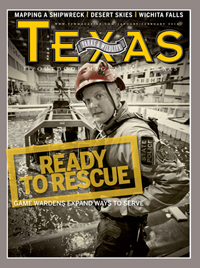
Picture This: Shooting in Winter
Adjustments are required when cold and snow enter the picture.
By Earl Nottingham
Unlike the idyllic and predictable winter snowscapes you can find gracing postcards or calendars from the northern states, Texas winter scenes can be a hit-or-miss proposition. When they do occur, they don’t hang around very long. However, for the photographer who is ready at a moment’s notice, the rugged Texas landscape can become a delicate beauty while cloaked ever so briefly in a blanket of white.
Unlike the moderate weather conditions we usually experience, cold weather photography comes with its own set of concerns. Here are some tips to help make your winter photography easier.


1. Metering. Without a doubt, the No. 1 problem most folks have with snow scene images is an overall gray cast instead of beautiful white snow. Most camera meters don’t know that a scene — or object — is supposed to be rendered white. Instead it assumes that most objects in a scene have varying tonal values ranging from black to white but average out to a middle gray. It thus sets the exposure accordingly. The trick is to override (fool) the meter by manually opening up the aperture by one to two f-stops or by using the exposure compensation dial found on most newer cameras to compensate anywhere between +1 and +2. Some cameras actually include a “snow” setting, which accomplishes the same result — turning gray snow to white.
2. Pastel light. While daylight snow scenes are the easiest to shoot, don’t miss the opportunities for pre-sunrise and post-sunset lighting. The soft pastels produced by these low-light periods produce a delicate feel. Just remember to use a tripod or other brace because of the inherent slow shutter speeds required for this type of light.
3. Gloves. It sounds like such a no-brainer, but trust me, you will find yourself shooting in cold weather one day without gloves. Numb fingers cannot turn dials on a camera, and trying to adjust a frozen tripod with bare hands is torture. Invest in the thinnest yet warmest gloves you can find that allow your fingers to remain dexterous and comfortable. I find that gloves with little “knobbies” help grip the controls better.
4. Camera grip/strap. Somewhat related to the previous tip is the use of a camera grip or strap. Trying to hold a cold camera with bulky gloves or clothing is difficult and can easily (and predictably) result in a dropped camera. Using a camera body or neck strap will prevent a very expensive accident.
5. Warm batteries. Cold batteries lose their charge very quickly. Make sure that your camera battery is fully charged before heading out, and consider keeping it in a warm pocket until ready to shoot. The last thing you want is for a battery to die just as you are ready to take that award-winning shot. It also doesn’t hurt to have a spare battery available, just in case.
Related stories
Picture This: The Gift of Optics
Picture This: Using Scale in Landscapes
Picture This: Highlights and Shadows
Picture This: The Exposure Triangle
Picture This: Getting Exposure Right
Picture This: The New Crop of Cameras
Picture This: Kids and Cameras
Picture This: Gifts for Shutterbugs
Picture This: Video for Everyone
Picture This: Shooting Fall Color
Picture This: The Art of Seeing
Picture This: The Rule of Thirds
Picture This: Sensors and Sensitivity
Picture This: There's an App for That
Picture This: Photo Contest Winners
Picture This: Keeping Your Camera Steady
Picture This: Retiree's Photo Sessions Reflect the Nature of the Day
Picture This: Getting Colors Right With White Balance
For more on TP&W magazine photography, go to our Photography page

